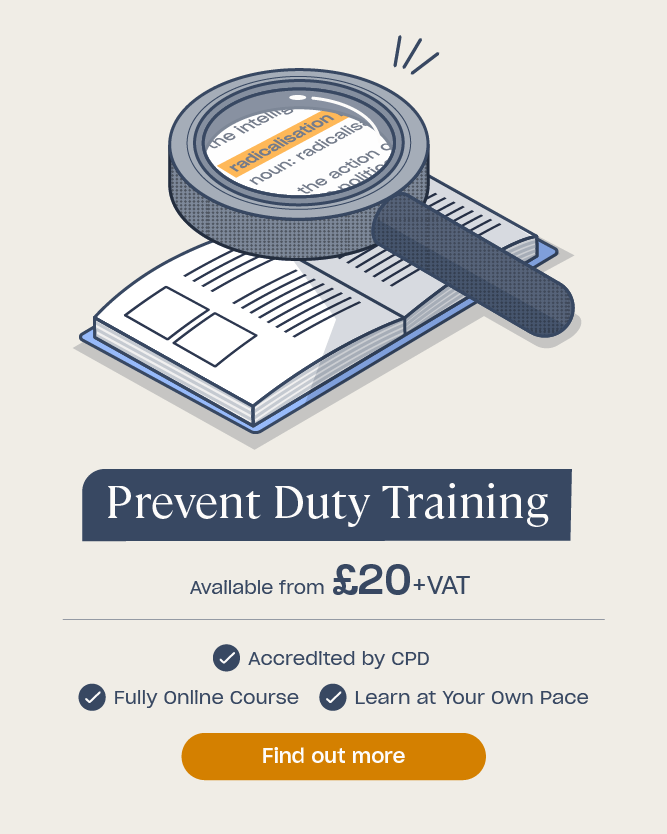What Does Extremism Mean?
Extremism can cause serious harm to everyone involved and is an issue that influences individuals of any age, background or setting. Understanding how certain extremist views and actions can cause real harm is vital, especially if you work with children or young adults. In this article we’ll outline what extremism is, explore the causes and signs to look out for and explain how you can help to prevent extremism in your setting.
What is Extremism?
Extremism means having beliefs or acting in ways that are far outside what most people in society consider normal. It often involves rejecting things like democracy, human rights or the law. Extremism can show up in both thoughts and actions and it may encourage hatred, intolerance or violence. These ideas and behaviours can harm individuals, families, and communities.
Extremism is not limited to one faith or political persuasion: it may be rooted in religious, political, social or environmental ideologies. It can also affect people of all ages, including children, young people and adults, and this is what makes it such a concern for those who work in a setting where children are present.

Extremism is the outcome of radicalisation – the process through which a person comes to support or become involved in extremist ideologies. For children and young people, radicalisation can be particularly dangerous as it can influence their life choices, relationships and future prospects at such an important stage of life.
Types of Extremism
Extremism can take various forms depending on the ideology or cause and each type can display different characteristics. However, they all share a common thread of intolerance, rigidity of thought and often a desire to override the rights or freedoms of others. Some of the main types of extremism include:
- Religious extremism – when religious beliefs are taken to an extreme and are used to justify intolerance, discrimination or violence.
- Political extremism – when far-right or far-left ideologies reject democratic processes and promote authoritarian control, exclusion or persecution.
- Single-issue extremism – when a person or group becomes fixated on one cause (such as the environment or animal rights) and uses extreme tactics to pursue it.
- Ideological extremism – when beliefs about identity, culture, gender or nationality lead to hostility towards others perceived as outside the group.
Causes of Extremism
There’s no single pathway into extremism as various personal and social factors can increase someone’s vulnerability to extremist influences, whether they’re an adult or a child. It’s also important to recognise that these factors don’t automatically mean someone will adopt extremist views, but they do increase vulnerability and risk.
Some of the contributing factors that can cause extremism include:
- Social isolation and exclusion – feeling cut off from family, friends or community can make people more susceptible to groups that offer identity and acceptance.
- Exposure to extremist content – online platforms and social media can provide access to extremist propaganda or enable grooming and recruitment efforts.
- Grievance or injustice – real or perceived injustice, discrimination or sense of being treated unfairly can lead individuals to seek explanations or belong to movements demanding change.
- Identity, belonging or purpose – people who struggle with questions of identity, feel undervalued or lack a sense of direction may be drawn to extremist ideas that promise meaning, status or change.
- Peer or family influence – friends or family members with extremist views, or social groups seeking radical change, can influence someone’s beliefs and behaviours.
- Lack of critical thinking or media literacy – without the skills to evaluate information, separate fact from propaganda or challenge extremist messaging through critical thinking, young people may become more vulnerable to harmful narratives.

Signs of Extremism
It’s important to notice early signs that someone might be getting involved in extremism, whether they’re a child or an adult. Extremism can be both non-violent or violent, and it often develops slowly over time.
The signs of extremism listed below may be worrying, but they don’t necessarily mean someone is involved in extremist activity. It’s important to consider the full context, their background and any patterns in their behaviour before making a professional judgment. These indicators also don’t cover every possible sign, but they can be helpful warnings when seen together with other changes in behaviour.
Signs of extremism might include:
- Expressing extreme or intolerant views towards others.
- Justifying or glorifying violence as a legitimate way to address a problem.
- Becoming increasingly isolated from friends and family.
- Displaying sudden changes in behaviour, mood or personal appearance.
- Spending an increasing amount of time in unregulated online spaces, sharing extremist or hateful content.
- Rejecting or showing disdain for democratic values, human rights or tolerance of difference.
- Associating with known extremist individuals, organisations or movements.
- Feeling under threat, exploited or deliberately choosing to withdraw from mainstream society.
Want to Learn More?
Learn more about how to identify and respond to extremist risks with our Prevent Duty Training, ideal for anyone working in education, healthcare or a sector with potentially vulnerable children or adults.
How to Prevent Extremism
Preventing extremism involves proactive steps and collaboration across sectors and communities. By focusing on early intervention, building knowledge and creating supportive environments, you can play a part in reducing the risk of extremism.
Some practical ways to help prevent extremism in your setting include:
- Encourage open and respectful dialogue, as supporting safe spaces to discuss controversial topics helps young people to feel heard.
- Promote inclusion and belonging by helping individuals feel valued, accepted and connected. This reduces the appeal of radical groups that promise identity or community.
- Strengthen critical thinking and media literacy by teaching how to assess information, recognise bias and challenge extremist narratives.
- Be vigilant and act early. If you have concerns about a child’s beliefs or behaviour, follow your organisation’s safeguarding procedures.
- Understand the Prevent duty: in England and Wales, specified organisations must understand the guidance and know how to prevent people from being drawn into extremism.
- Work together across agencies, as safeguarding children and adults from extremism requires multi-agency working and contributions from education, healthcare, social services, police and community groups.
- Create positive role models and promote cultural awareness. Encouraging respect for difference and providing constructive alternatives to extremist narratives helps build healthier communities.

Extremism poses a significant risk to individuals, families and communities, so understanding what extremism is, recognising possible causes and knowing how to respond can make a meaningful difference, especially if you work with children and young people. With awareness, education and cooperative action, we can all contribute to safeguarding others and creating more inclusive and resilient societies.











